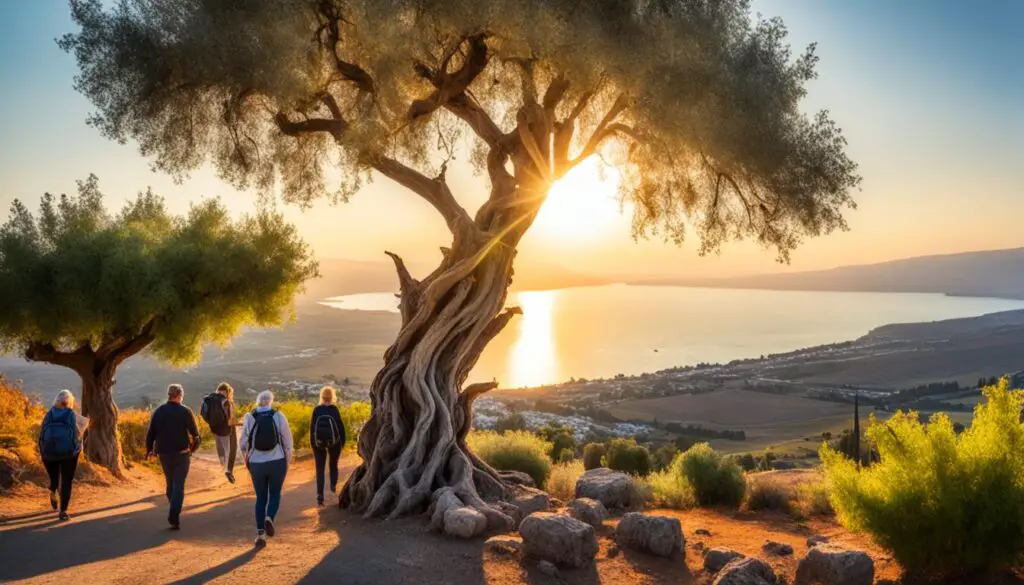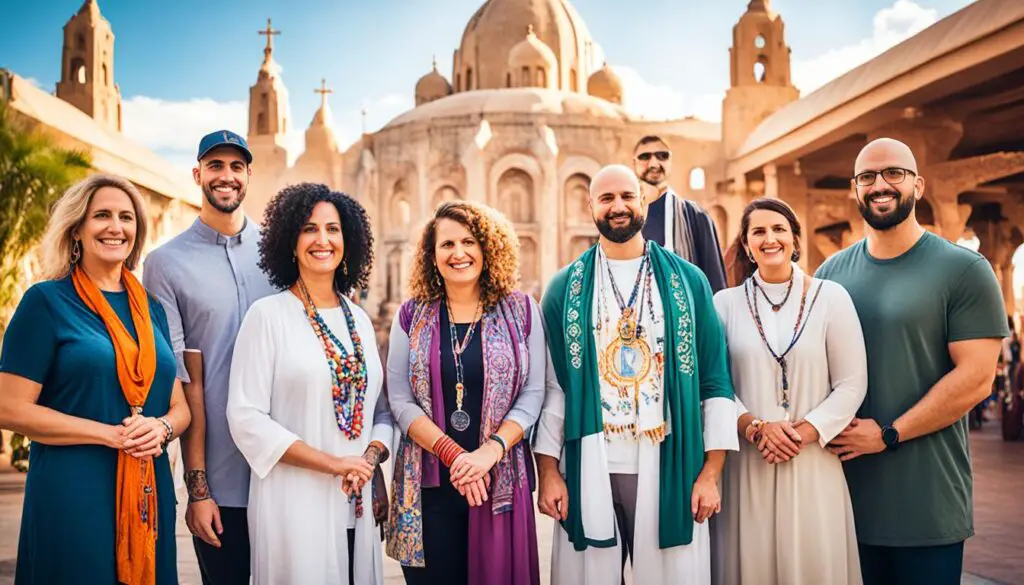Embark on a spiritual journey like no other as we explore the sacred Christian holy sites scattered across the globe. From ancient churches to revered biblical locations, these pilgrimage destinations offer a profound encounter with history, culture, and faith.
Our guidebook takes you on a curated tour of Christian holy sites in Israel, Egypt, Jordan, Greece, and Turkey, unveiling their deep theological significance and providing valuable insights into their historical and cultural contexts. Join us on this remarkable adventure as we delve into the heart of Christianity.
Key Takeaways:
- Discover the most revered Christian holy sites, from historical churches to sacred biblical locations.
- Explore pilgrimage destinations in Israel, Egypt, Jordan, Greece, and Turkey.
- Gain a deep understanding of the historical, cultural, and theological significance of each site.
- Embark on a spiritual journey that goes beyond visiting places; it is an encounter with God and a chance for spiritual growth.
- Uncover the transformative power of pilgrimage and its role in deepening faith and renewing the spirit.
The Importance of Christian Pilgrimage
Pilgrimage has been a significant practice for Christians since the fourth century. It allows believers to walk in the footsteps of biblical figures, deepen their faith, and seek spiritual renewal. Christians from all over the world embark on journeys to visit important pilgrimage destinations and holy sites, such as:
These sacred places hold immense religious and historical significance, drawing millions of pilgrims each year. Moreover, there are numerous pilgrim routes across the UK, Europe, and beyond, providing diverse opportunities for spiritual exploration and growth.
Christian pilgrimage is not merely a physical journey; it is also an inner quest to forge a closer relationship with God. It encompasses introspection, prayer, and devotion, leading to a profound connection with the divine. As pilgrims follow the footsteps of biblical figures, they gain a deeper understanding of their faith, enabling them to navigate their own spiritual path.
“Pilgrimage is an opportunity to reflect on our faith, find solace in prayer, and experience the transformative power of spiritual exploration.” – Reverend James Johnson
The Spiritual Significance of Christian Holy Sites
Christian holy sites hold great spiritual importance, as they are associated with the life and teachings of Jesus Christ and other biblical figures. Visiting these sites allows pilgrims to immerse themselves in the rich tapestry of Christian history and experience the profound connections between faith, culture, and heritage.
Some of the most revered Christian sacred sites include:
| Site | Location |
|---|---|
| Church of the Holy Sepulchre | Jerusalem, Israel |
| Vatican City | Rome, Italy |
| Canterbury Cathedral | Canterbury, England |
These sites offer a unique opportunity for pilgrims to connect with biblical events and deepen their understanding of scripture. Walking in the footsteps of Jesus and other religious figures can evoke powerful emotions and bring religious teachings to life.
The Spiritual Significance of Holy Land Pilgrimage
Holy Land pilgrimage holds a special place in the hearts of Christians. It offers a unique opportunity to recommit oneself to living a Christian life and to experience the land where Jesus was born, preached, suffered, died, and rose again. Visiting the Holy Land allows pilgrims to deepen their faith, gain a deeper understanding of biblical stories, and connect with the rich Christian history. It is a spiritual journey that goes beyond simply visiting places; it is an encounter with God and a chance for spiritual growth.
Pilgrims who embark on a journey to the Holy Land are drawn to the sacredness and significance of the Biblical sites they visit. These holy sites hold immense spiritual importance and serve as tangible reminders of the stories and teachings found in the Bible. Walking in the footsteps of Jesus and his disciples, pilgrims can seek solace, find inspiration, and deepen their relationship with God.
Throughout history, countless pilgrims have been moved by the transformative power of visiting the Christian holy sites in the Holy Land. The biblical sites, such as the Church of the Holy Sepulchre in Jerusalem, the Church of the Nativity in Bethlehem, and the Mount of Olives, resonate with believers on a profound level, enabling them to connect with the life and teachings of Jesus Christ.
“The pilgrimage to the Holy Land has transformed my faith and deepened my understanding of God’s love. Walking in the places where Jesus once walked has brought the Bible to life for me and has filled me with a renewed sense of purpose and devotion.” – Sarah, pilgrim
For many, the Holy Land pilgrimage is a once-in-a-lifetime opportunity to delve into the roots of their faith, to encounter the living history of Christianity, and to be spiritually rejuvenated. It is a pilgrimage filled with awe, reverence, and a deep sense of connection to the divine.
Deepening Faith and Understanding
Stepping foot on the same grounds that Jesus once walked allows pilgrims to experience a profound sense of spirituality. It provides a unique perspective that goes beyond reading scriptures or hearing sermons. The tangible presence of these biblical sites fosters a deeper understanding of God’s plan, the life of Jesus, and the early Christian communities.
By visiting the Christian holy sites, pilgrims can witness the stories of the Bible come to life. They can stand at the Jordan River, where Jesus was baptized, and reflect on the significance of baptism in their own lives. They can walk through the Via Dolorosa, tracing Jesus’ footsteps and meditating on his sacrifice. They can visit the Church of the Multiplication of the Loaves and Fishes in Tabgha, where Jesus performed the miracle of feeding the multitude, and contemplate the abundance of God’s provision.
These encounters with the biblical sites deepen pilgrims’ faith and offer a sense of confirmation that the events described in the Bible are not mere stories but real, transformative moments in history. It strengthens their belief in the power of God’s love, the message of redemption, and the eternal hope found in Jesus Christ.
An Encounter with God
Visiting the holy sites of the Holy Land is not merely a sightseeing tour, but an opportunity for pilgrims to encounter God in a profound way. These sacred places become spaces for worship, prayer, and reflection, enabling pilgrims to connect with the divine and experience spiritual renewal.
In the tranquil atmosphere of the Church of the Holy Sepulchre, pilgrims can enter the empty tomb of Jesus and contemplate the miracle of his resurrection. The Garden of Gethsemane provides a peaceful setting for prayer and contemplation, allowing pilgrims to empathize with Jesus during his moments of anguish before his crucifixion.
Every step taken in the Holy Land is an invitation to commune with God, to seek guidance, forgiveness, and strength. As pilgrims navigate the winding streets of Jerusalem or hike the rugged trails of Galilee, they can engage in personal conversations with God, pouring out their hearts and listening for His voice.
Through prayer, meditation, and engagement with the holy sites, pilgrims can experience a deep sense of peace, joy, and spiritual fulfillment. The Holy Land pilgrimage offers a sacred space for encountering God and invites believers to embrace the transformative power of His presence.
Spiritual Growth and Transformation
Embarking on a pilgrimage to the Holy Land is a commitment to spiritual growth and transformation. It is an invitation to journey closer to God, to deepen one’s faith, and to live out the teachings of Jesus Christ.
The pilgrimage experience challenges pilgrims to step out of their comfort zones, to confront their doubts, and to grapple with the complexities of their faith. It provides an opportunity for self-reflection, soul-searching, and introspection.
By immersing themselves in the rich Christian history and engaging with the cultural and religious diversity of the Holy Land, pilgrims can broaden their perspectives, challenge their preconceived notions, and cultivate a deeper appreciation for the unity of the global Christian family.
Pilgrimage is not only a personal journey but also a communal one. It allows pilgrims to connect with fellow believers from different parts of the world, to share their faith experiences, and to build meaningful relationships. The camaraderie fostered during the pilgrimage journey can inspire and support pilgrims in their lifelong walk of faith.
In essence, the Holy Land pilgrimage is an invitation to embark on a transformative spiritual journey. It offers an opportunity to deepen one’s faith, encounter God, and grow in spiritual maturity. By visiting the Christian holy sites, pilgrims can connect with the biblical stories at a profound level, experience the transformative power of God’s presence, and emerge from the pilgrimage journey with renewed devotion, clarity, and purpose.
Practical Considerations for Holy Land Pilgrimage
Embarking on a pilgrimage to the Christian holy sites in the Holy Land is a profound and transformative experience. However, careful planning and preparation are essential to ensure a smooth and meaningful journey. In this section, we provide practical advice and considerations to help you make the most of your pilgrimage.
1. Planning Your Pilgrimage
Before embarking on your pilgrimage, take the time to research and plan your itinerary. Identify the Christian holy sites you wish to visit, such as the Church of the Holy Sepulchre in Jerusalem or the Church of the Nativity in Bethlehem. Consider including other historical churches and landmarks that resonate with your faith.
Ensure you have a clear understanding of the visa requirements, entry restrictions, and the best time to visit. Keep in mind that certain sites may have specific visiting hours or limited access due to ongoing religious ceremonies.
2. Finding Accommodations
When selecting accommodations for your pilgrimage, consider staying in establishments that cater to religious tourists. Many hotels and guesthouses in the Holy Land offer comfortable and convenient options for pilgrims, making it easier to access the Christian holy sites and participate in religious activities.
Look for accommodations situated close to the holy sites you plan to visit. This will save you transportation time and allow you to immerse yourself in the spiritual atmosphere of the region.
3. Navigating Cultural Differences
The Holy Land is a diverse region with a rich cultural heritage. As a pilgrim, it is important to recognize and respect the local customs and traditions. Familiarize yourself with the basic etiquette and dress codes specific to each religious site you visit.
Engage with locals respectfully and be mindful of their cultural sensitivities. Demonstrating appreciation for their traditions will enhance your overall pilgrimage experience and foster positive interactions with the local community.
4. Connecting with Local Communities
One of the most enriching aspects of a Holy Land pilgrimage is the opportunity to connect with the local Christian communities. Attend worship services, interact with church members, and participate in community activities. This will not only deepen your understanding of the Christian faith but also provide a chance to offer support and solidarity to these vibrant communities.
5. Embracing the Vibrant History and Culture
The Holy Land is steeped in history and boasts a vibrant cultural heritage. Take the time to explore beyond the Christian holy sites and visit museums, archaeological sites, and historical landmarks. Immerse yourself in the local culture by savoring traditional cuisine, attending cultural events, and discovering the unique traditions of the region.

This image showcases the breathtaking historical churches you can visit during your pilgrimage. These sacred spaces are not only architectural marvels but also hold immense religious and historical significance.
Summary
A successful Holy Land pilgrimage requires careful planning, cultural sensitivity, and a desire to connect deeply with the Christian holy sites, local communities, and vibrant history of the region. By following these practical considerations, you can ensure a meaningful and transformative pilgrimage experience.
| Key Considerations for Holy Land Pilgrimage |
|---|
| Plan your itinerary, including the Christian holy sites and historical churches you wish to visit. |
| Choose accommodations conveniently located near the holy sites to optimize your time. |
| Respect the local customs, cultural differences, and dress codes of the region. |
| Engage with the local Christian communities, attend worship services, and show solidarity. |
| Explore the vibrant history and culture of the Holy Land beyond the holy sites. |
The Holy Land: A Journey of Faith and Solidarity
A pilgrimage to the Holy Land is not just a personal journey; it is an opportunity to build solidarity with the local Christian communities. When visiting the Christian holy sites and religious landmarks in the Holy Land, pilgrims have a unique chance to support and strengthen the Church in the region, which faces various challenges and pressures.
By learning about the local religious traditions and engaging with the diverse peoples of the Holy Land, pilgrims can foster a deeper understanding and appreciation of the rich cultural heritage and history that these sacred sites hold. This spiritual tourism experience can inspire a sense of unity and connection among people of different backgrounds and faiths.
In addition to spiritual growth, a pilgrimage to the Holy Land can also serve as a catalyst for promoting justice and peace. Witnessing firsthand the complex realities faced by the local communities, pilgrims are encouraged to work towards positive change upon their return. Whether through supporting local initiatives, raising awareness about the challenges faced by these communities, or advocating for social justice, the journey becomes a transformative experience.
“A pilgrimage to the Holy Land is an opportunity for both personal spiritual growth and building solidarity with the local Christian communities. It is a chance to deepen one’s faith, connect with diverse cultures, and contribute to the pursuit of justice and peace and religious landmarks.”
As pilgrims embark on this journey of faith and solidarity, they carry the spirit of pilgrimage with them long after their visit. The experience challenges them to examine their own lives, values, and commitments, and to promote understanding and compassion in their respective communities.
By embracing the values of faith, harmony, and unity, a pilgrimage to the Holy Land becomes a transformative experience that can inspire individuals to become ambassadors of peace and goodwill in their own lives, fostering a more inclusive and compassionate world.

| Holy Land Christian Community Challenges | Opportunities for Support and Solidarity |
|---|---|
| Political instability | Advocacy for peace and justice initiatives |
| Emigration | Supporting local Christian businesses and initiatives |
| Religious tensions | Engaging in interfaith dialogue and cooperation |
| Socio-economic disparities | Supporting educational and community development projects |
The Significance of Interreligious Ties in the Holy Land
The Holy Land is a place where Judaism, Christianity, and Islam converge, making interreligious dialogue and understanding crucial. Pilgrims are encouraged to embrace encounters with people of different faiths and learn about the shared heritage and holy sites of the three monotheistic religions. By fostering relationships and promoting reconciliation, pilgrimage becomes an opportunity to contribute to peace and unity in the region.

Visiting the holy sites of the Holy Land allows pilgrims to experience the essence of these three major religions and gain a deeper understanding of their interconnectedness. It is a chance to witness the coexistence and interdependence of faiths, which is a testament to the harmonious diversity that exists in this sacred region.
Engaging in interreligious dialogue during a pilgrimage fosters mutual respect and builds bridges of understanding. By actively seeking opportunities to reach out and converse with people of different religious backgrounds, pilgrims can transcend cultural and religious differences, promoting a sense of empathy and unity.
“In the Holy Land, where Christianity, Judaism, and Islam converge, believers have a unique opportunity to deepen their faith and cultivate interreligious dialogue, fostering peace and mutual understanding.”
Pilgrims can also learn about the shared heritage and historical connections between these faiths. Exploring sites such as the Western Wall, the Church of the Holy Sepulchre, and the Dome of the Rock allows pilgrims to witness the profound reverence these places hold for Jews, Christians, and Muslims alike.
Shared Holy Sites in the Holy Land
Here are some of the notable shared holy sites in the Holy Land:
| Judaism | Christianity | Islam |
|---|---|---|
| The Western Wall | The Church of the Holy Sepulchre | The Dome of the Rock |
| The Tomb of Rachel | The Mount of Olives | Al-Aqsa Mosque |
| The Tomb of the Patriarchs | The Sea of Galilee | The Cave of the Patriarchs |
These shared holy sites symbolize the interconnectedness and historical significance of these three religions, underscoring the importance of interreligious ties in the Holy Land.
By promoting understanding, respect, and solidarity among people of different faiths, religious tourism in the Holy Land can contribute to peace, tolerance, and unity in the region and beyond.
Pilgrimage as a Journey of Reconciliation and Justice
Pilgrimage is not just a physical journey; it has the power to transform individuals and inspire a commitment to justice and peace. When embarking on a pilgrimage to the Christian holy sites, it is crucial to understand the complex political situation in the Holy Land and the challenges faced by the local Christian communities. By immersing themselves in the local culture, listening to local voices, and becoming agents of positive change, pilgrims can contribute to efforts for reconciliation.
Visiting the pilgrimage destinations is an opportunity to learn about the struggles and aspirations of the people who call the Holy Land home. It is a chance to witness the ongoing efforts for peace and justice in the region. By engaging with the local communities, pilgrims can build bridges of understanding and solidarity, fostering connections that transcend religious and cultural differences.
Pilgrims are encouraged to be advocates for justice, raising awareness about the challenges faced by the local Christian communities upon their return. Sharing their experiences and knowledge gained during the pilgrimage can help shape perceptions and promote support for the people of the Holy Land. Through these efforts, pilgrims become ambassadors of goodwill, promoting reconciliation, and contributing to a more just and peaceful world.
Pilgrimage is not only a personal journey; it is also a call to action. It challenges us to reevaluate our role in the pursuit of justice and peace and empowers us to be agents of positive change.
Solidarity with Holy Land Christians
The Church in the Holy Land plays a unique and crucial role in preserving the Christian heritage and promoting peace in the region. The local Christian communities face various challenges such as emigration and political instability. It is essential for pilgrims to demonstrate solidarity with these communities and support their efforts.
By supporting local churches, pilgrims contribute to the preservation of sacred religious landmarks and the continued practice of faith in the Holy Land. Building relationships with diverse Christian denominations fosters unity and mutual understanding.
One way to show solidarity is by raising awareness about the plight of Christians in the Holy Land. By sharing their experiences and educating others about the challenges faced by local Christians, pilgrims can inspire empathy and understanding.
It is crucial to remember that pilgrimage destinations are not just historical sites, but living communities with real people facing real struggles. Pilgrims are encouraged to engage with the local Christian communities, listen to their stories, and provide support in any way possible.
Supporting Local Churches
Local churches rely on the support of pilgrims and visitors to carry out their ministries and maintain their facilities. By attending Mass, participating in liturgical celebrations, and making donations, pilgrims contribute to the sustainability of these religious institutions.
“When we support local churches in the Holy Land, we are not only investing in the preservation of these sacred sites, but also in the wellbeing of the local Christian communities who rely on them for their spiritual nourishment and livelihoods.”
Fostering Relationships with Diverse Christian Denominations
The Holy Land is home to various Christian denominations, each with its own rich traditions and practices. Pilgrims are encouraged to engage with these diverse communities, attend services at different churches, and learn about their distinct spiritual heritage.
By embracing the diversity of Christian denominations, pilgrims foster unity and contribute to the promotion of interreligious dialogue and understanding. This experience of shared faith can be a source of inspiration and deep spiritual growth.

Raising Awareness about Christians in the Holy Land
The plight of Christians in the Holy Land often goes unnoticed by the wider world. By sharing their experiences and stories, pilgrims can raise awareness about the challenges these communities face, including emigration, political instability, and economic hardships.
“By spreading the word and educating others about the reality of Christians in the Holy Land, we can help create a greater sense of empathy, understanding, and support for these communities.”
Pilgrims can write about their experiences, share photos and videos on social media, or participate in discussions and events that focus on the Holy Land. These efforts can make a difference and inspire others to get involved in supporting the Christian communities in the region.
By standing in solidarity with Holy Land Christians, pilgrims demonstrate their commitment to the Christian faith, promote peace, and contribute to the preservation of religious landmarks for future generations.
The Journey of Pilgrimage
Pilgrimage is not just a physical journey; it is a spiritual quest to encounter God in a deeper way. When embarking on a pilgrimage to Christian holy sites, such as the revered biblical sites in the Holy Land, pilgrims experience a unique opportunity for personal reflection, renewal, and spiritual growth.
During the pilgrimage, pilgrims are encouraged to approach their journey with an open heart and a desire to connect with the divine. It is a time for self-discovery, as they reflect on their faith, seek answers to their spiritual questions, and gain a deeper understanding of their relationship with God.
The transformative nature of pilgrimage lies not only in the places visited but also in the inner journey it inspires. As pilgrims walk the paths of biblical figures and visit sacred sites, they are immersed in a rich tapestry of history, culture, and spirituality. Through prayer, meditation, and contemplation, pilgrims find solace and connect with the divine presence that permeates these holy sites.
“Pilgrimage is not just a spiritual journey; it is a transformative experience that has the power to shape one’s faith and perspective on life.” – Unknown
Prayer and devotion play a central role in the pilgrimage experience. Whether it’s participating in Mass at a historical church or offering heartfelt prayers at a biblical site, pilgrims find solace in communing with God in these sacred spaces. The moments of silence and reflection allow pilgrims to deepen their connection with the divine and find renewed strength and inspiration for their spiritual journey.
As the pilgrimage comes to an end, pilgrims carry with them a sense of renewal, an enhanced spiritual perspective, and a deeper connection to their faith. The journey of pilgrimage continues beyond the physical return, as the experiences and insights gained during the pilgrimage shape their lives and influence their relationship with God and others.
Embrace the transformative power of pilgrimage. Let the Christian holy sites become the backdrop for your spiritual journey, as you seek to encounter God in a deeper way and experience the profound connection between faith, history, and culture.

Tips for a Meaningful Holy Land Pilgrimage
Embarking on a Holy Land pilgrimage can be a profound and transformative experience, allowing you to connect with the rich spiritual heritage of Christianity. To make the most of your pilgrimage, here are some practical tips and advice to guide you along the way.
Select Knowledgeable Guides
Choosing knowledgeable guides who are well-versed in the history, significance, and biblical narratives associated with the Christian holy sites is essential. Their expertise will provide valuable insights and enhance your understanding of the sites you visit.
Plan Your Itinerary
Plan your itinerary carefully to ensure you have enough time to visit the desired pilgrimage destinations. Research the opening hours, special events, and any restrictions that may be in place. This will help you make the most of your time and ensure you don’t miss any key sites.
Participate in Liturgical and Devotional Practices
Immerse yourself in the spiritual atmosphere of the Holy Land by participating in liturgical and devotional practices. Attend Mass or prayer services at the holy sites, engage in personal prayer and reflection, and take part in any spiritual activities offered at the pilgrimage destinations.
Engage with the Local Communities
Interact with the local Christian communities you encounter during your pilgrimage. Engaging with the people, customs, and traditions of the Holy Land will enrich your experience and foster a deeper connection to the spiritual significance of the sites you visit.
Cultivate a Spirit of Reverence, Gratitude, and Openness
Approach your pilgrimage with a spirit of reverence, gratitude, and openness. Be mindful of the sacredness of the sites you visit, express gratitude for the opportunity to make this spiritual journey, and remain open to the transformative experiences and encounters that may await you.
“A Holy Land pilgrimage is not just about visiting places; it is about encountering God in a deeper way and allowing Him to work in our hearts and lives.”
Remember, a Holy Land pilgrimage is a unique opportunity for spiritual growth, reflection, and connection with the divine. By following these tips and immersing yourself fully in the experience, you can make your pilgrimage a truly meaningful and transformative journey.
Comparison of Christian Holy Sites
| Destination | Significance | Key Sites |
|---|---|---|
| Jerusalem, Israel | The birthplace of Christianity; holds immense religious significance for Christians, Jews, and Muslims | The Church of the Holy Sepulchre, the Western Wall, the Dome of the Rock |
| Rome, Italy | The heart of the Catholic Church; home to numerous important Christian sites and relics | The Vatican, St. Peter’s Basilica, the Colosseum, the Catacombs of Rome |
| Canterbury, England | A major center of Christian pilgrimage since the Middle Ages; associated with Archbishop Thomas Becket | Canterbury Cathedral, St. Augustine’s Abbey, Canterbury Tales Museum |
Conclusion
A pilgrimage to the Christian holy sites of the Holy Land is a transformative and deeply spiritual journey. It is an opportunity to embark on a sacred pilgrimage, connect with the rich tapestry of Christian history, and explore destinations that hold profound religious significance.
Visiting these pilgrimage destinations allows believers to deepen their faith, strengthen their spiritual connection, and gain a deeper understanding of biblical stories. By immersing oneself in the historical, cultural, and theological context of these holy sites, pilgrims can experience a sense of awe and reverence that transcends the physical journey.
Furthermore, a pilgrimage to the Holy Land is not only a personal journey, but also an opportunity to support and uplift the local Christian communities. By embracing encounters with people of different faiths and promoting peace and justice, pilgrims become agents of positive change in the Holy Land. They carry the spirit of their pilgrimage with them long after their journey ends, inspiring others to embark on their own spiritual quest.
FAQ
What are some famous Christian holy sites?
Some famous Christian holy sites include Jerusalem (including the Church of the Holy Sepulchre and the Western Wall), Rome (including St. Peter’s Basilica and the Vatican), Canterbury Cathedral, and Mount Sinai in Egypt.
What is the significance of pilgrimage for Christians?
Pilgrimage holds spiritual significance for Christians as it allows them to walk in the footsteps of biblical figures, deepen their faith, and seek spiritual renewal. It is an opportunity to encounter God in a deeper way and strengthen one’s relationship with the divine.
Why is the Holy Land important for Christian pilgrimage?
The Holy Land holds a special place in the hearts of Christians as it is the land where Jesus was born, preached, suffered, died, and rose again. Visiting the Holy Land offers pilgrims the chance to deepen their faith, gain a deeper understanding of biblical stories, and connect with the rich Christian history.
What should I consider when planning a pilgrimage to the Holy Land?
When planning a pilgrimage to the Holy Land, it is important to consider logistics and practicalities such as accommodations, cultural differences, and local norms and traditions. It is also important to connect with local communities, support the Church in the Holy Land, and immerse oneself in the vibrant culture and history of the region.
How can pilgrimage contribute to peace and unity in the Holy Land?
Pilgrimage can contribute to peace and unity in the Holy Land by fostering interreligious dialogue and understanding. Encountering people of different faiths and learning about the shared heritage and holy sites of Judaism, Christianity, and Islam can promote reconciliation and contribute to peace in the region.
How can pilgrimage be a journey of justice and peace?
Pilgrimage can be a journey of justice and peace by understanding the complex political situation in the Holy Land, being aware of the challenges faced by local Christian communities, and supporting efforts for reconciliation. Pilgrims can become agents of positive change by raising awareness and working towards justice and peace upon their return.
How can I support the local Christian communities in the Holy Land?
To support the local Christian communities in the Holy Land, pilgrims are encouraged to engage with diverse Christian denominations, build relationships with local churches, and raise awareness about the challenges faced by Christians in the region. Solidarity with the local Christian communities is crucial for preserving the Christian heritage and promoting peace in the Holy Land.
Is pilgrimage only a physical journey?
No, pilgrimage is not just a physical journey; it is also a spiritual quest to encounter God in a deeper way. It offers the opportunity for personal reflection, renewal, prayer, and devotion. Pilgrims are encouraged to approach their pilgrimage with an open heart and a desire for spiritual growth and connection with the divine.
What practical tips can enhance my Holy Land pilgrimage experience?
Some practical tips for enhancing a Holy Land pilgrimage experience include selecting knowledgeable guides, carefully planning the itinerary, participating in liturgical and devotional practices, and engaging with the local communities. It is important to embrace the unique spiritual opportunities offered by the Holy Land and cultivate a spirit of reverence, gratitude, and openness throughout the journey.
What is the lasting impact of a Holy Land pilgrimage?
A Holy Land pilgrimage can be a transformative and deeply spiritual journey. It offers the opportunity to connect with the rich Christian history, deepen one’s faith, and support the local Christian communities. Pilgrims carry the spirit of pilgrimage with them long after their journey ends, becoming agents of positive change in the Holy Land and in their own lives.







